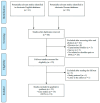Bee Venom Acupuncture for Shoulder Pain: A Literature Review of Clinical Studies
- PMID: 39591256
- PMCID: PMC11598799
- DOI: 10.3390/toxins16110501
Bee Venom Acupuncture for Shoulder Pain: A Literature Review of Clinical Studies
Abstract
Managing shoulder pain typically involves the use of acetaminophen or oral nonsteroidal anti-inflammatory drugs, but prolonged use of these medications can lead to dependence and various side effects. To overcome the dose dependency and side effects of these conventional drugs, animal venoms have begun to be utilized. Among them, bee venom stands out for its powerful anti-inflammatory properties, which help relieve pain and treat chronic inflammatory conditions. This review evaluates the efficacy and safety of bee venom acupuncture (BVA) for shoulder pain. In March 2024, we searched 11 databases: 5 international and 6 Korean databases. We identified 23 clinical studies on BVA for shoulder pain. The causes of shoulder pain were post-stroke pain (43.5%), rotator cuff syndrome (17.4%), and brachial plexus palsy (13.0%). The BVA concentration and dosage per session were 0.005-1.0 mg/mL and 0.01-2.0 mL, respectively. All included clinical studies reported positive effects on pain outcomes. This review suggests that BVA, which involves injecting bee venom into acupuncture points, may serve as a viable alternative for pain management. However, the level of evidence in the included studies was low and adverse effects were reported infrequently, indicating that further research is needed.
Keywords: bee venom; bee venom acupuncture; clinical studies; shoulder pain.
Conflict of interest statement
The authors declare no conflicts of interest.
Figures
Similar articles
-
Clinical Evidence of Bee Venom Acupuncture for Ankle Pain: A Review of Clinical Research.Toxins (Basel). 2025 May 21;17(5):257. doi: 10.3390/toxins17050257. Toxins (Basel). 2025. PMID: 40423339 Free PMC article. Review.
-
Clinical Studies of Bee Venom Acupuncture for Lower Back Pain in the Korean Literature.Toxins (Basel). 2022 Jul 30;14(8):524. doi: 10.3390/toxins14080524. Toxins (Basel). 2022. PMID: 36006186 Free PMC article. Review.
-
Bee Venom Acupuncture for Neck Pain: A Review of the Korean Literature.Toxins (Basel). 2023 Feb 4;15(2):129. doi: 10.3390/toxins15020129. Toxins (Basel). 2023. PMID: 36828443 Free PMC article. Review.
-
Bee Venom Acupuncture Effects on Pain and Its Mechanisms: An Updated Review.Toxins (Basel). 2021 Aug 29;13(9):608. doi: 10.3390/toxins13090608. Toxins (Basel). 2021. PMID: 34564611 Free PMC article. Review.
-
Long-term effectiveness of bee venom acupuncture and physiotherapy in the treatment of adhesive capsulitis: a one-year follow-up analysis of a previous randomized controlled trial.J Altern Complement Med. 2014 Dec;20(12):919-24. doi: 10.1089/acm.2014.0220. J Altern Complement Med. 2014. PMID: 25380241 Clinical Trial.
Cited by
-
Harnessing bee venom for inflammatory diseases management: from traditional medicine to nanotechnology.Naunyn Schmiedebergs Arch Pharmacol. 2025 Aug;398(8):9797-9815. doi: 10.1007/s00210-025-03991-6. Epub 2025 Mar 12. Naunyn Schmiedebergs Arch Pharmacol. 2025. PMID: 40072552 Review.
-
Clinical Evidence of Bee Venom Acupuncture for Ankle Pain: A Review of Clinical Research.Toxins (Basel). 2025 May 21;17(5):257. doi: 10.3390/toxins17050257. Toxins (Basel). 2025. PMID: 40423339 Free PMC article. Review.
-
Effectiveness of Bee Venom Injection for Parkinson's Disease: A Systematic Review.Toxins (Basel). 2025 Apr 20;17(4):204. doi: 10.3390/toxins17040204. Toxins (Basel). 2025. PMID: 40278702 Free PMC article.
References
-
- Urwin M., Symmons D., Allison T., Brammah T., Busby H., Roxby M., Simmons A., Williams G. Estimating the burden of musculoskeletal disorders in the community: The comparative prevalence of symptoms at different anatomical sites, and the relation to social deprivation. Ann. Rheum. Dis. 1998;57:649–655. doi: 10.1136/ard.57.11.649. - DOI - PMC - PubMed
Publication types
MeSH terms
Substances
Grants and funding
LinkOut - more resources
Full Text Sources
Medical



